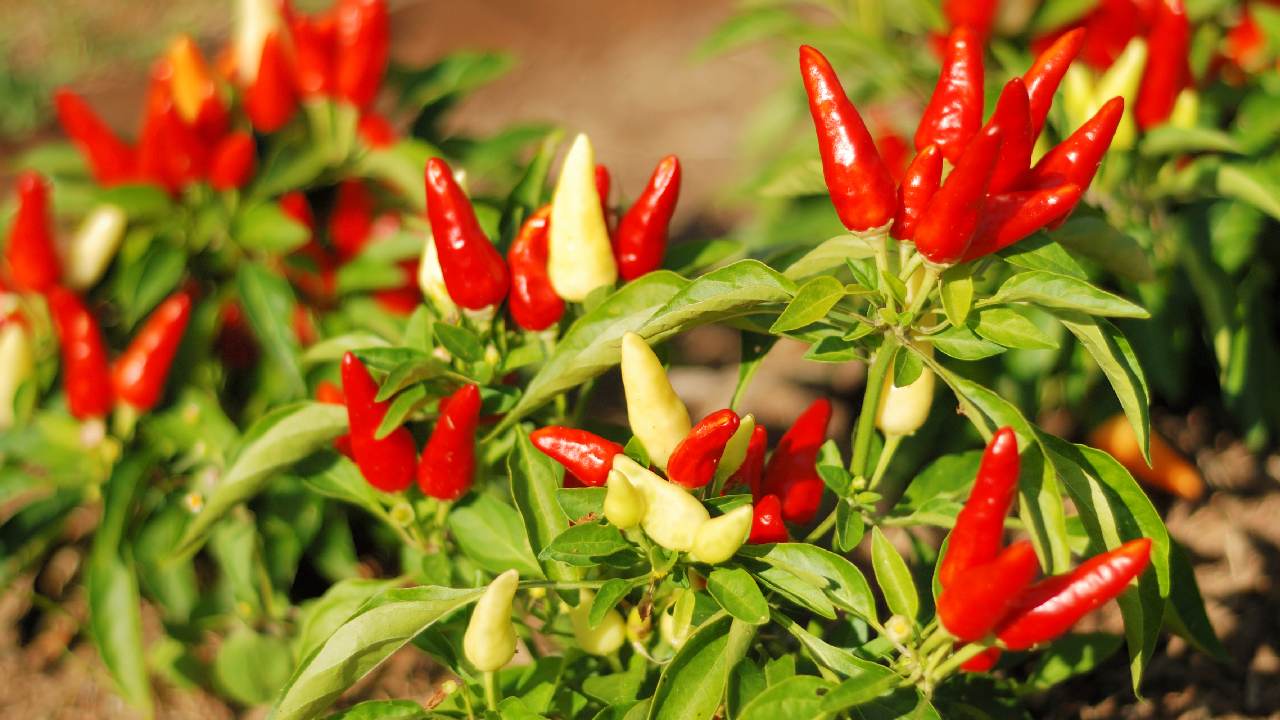Any chilli fanatic knows no two chillies are the same

As featured on Better Homes and Gardens, here is a complete guide to home-grown chilli.
Heat scale
The pith and seeds give chillies heat but even if you remove them, there will still be a kick in your food. The heat is measured in Scoville Heat Units (SHUs). Habanero is near the top while at the bottom is the humble capsicum with 1-100SHUs.
Types of chillies
Chillies don’t just have different levels of heat, they also have distinctive flavours – from sweet to citrus, apple to cucumber – and they also vary in colour and shape.
Here are some the most common types you'll find:
Capsicum annuum
Most well-known chilli and peppers are actually strains of capsicum. Some of these include jalapenos, bell peppers and chilli peppers.
Capsicum chinense
These are one of the hotter species of chilli and are used to add more heat to a dish, particularly stews and sauces.
Capsicum frutescens
This type is closely related to both Capsicum annuum and Capsicum chinense but grows a bit smaller. The most well-known are tabasco and Thai peppers.
Capsicum Baccatum
This unique type of chilli is notable for having citrus and fruity flavours and has only become popular in South American countries such as Peru and Brazil.
Capsicum pubescens
We’ve been eating this kind of purple pepper for so long that no-one knows what plant it comes from!
Rumba chilli
Rumble with this Rumba chilli, which is small but has a big impact. From the pretty purple flowers emerge passionate purple fruit that turns a fiery red, on your plant and on your tongue. It’s hot!
Caring for chillies:
Position
Chillies like a tropical, warm temperate. If you want to get the most out of your chillies, you’ll find that growing them in a warm, sheltered spot will make for the best flavour. They love full sun but in a hot climate, too much sun can dry them out. While chilli can tolerate a little bit of shade, make sure you keep them out of the wind as its branches are brittle and leaves can be easily torn.
Soil
Chilli will be happy in most garden soils, however, any soil too heavy, damp or wet will stunt its growth. Best to go for a free-draining quality garden soil. If growing in a pot, use a premium organic potting mix.
Watering
While the chilli is growing and fruit is developing, keep the plant moist but never wet. If growing in a pot, be sure to water regularly and avoid putting a saucer underneath.
Fertiliser
Feed your chilli with a controlled-release fertiliser at planting time or annually. Liquid fertiliser is great for potted seedlings, apply as per the label once a week or every ten days.
Pruning
At the start of the growing season – or especially if it’s in a shady spot – lightly tip prune new growth. After the last fruit has been picked and the plant is dropping leaves, you can prune it back quite a lot and trim any spindly branches.
Chilli is susceptible to several pests, but they are all easily treatable:
Snails leave holes and chew marks along leaf edges, so use a pet-friendly bail or homemade beer trap to keep them at bay.
Aphids can attack new growth but all you need is a commercial spray or homemade soapy garlic spray to get rid of them.
Fruit flies and white flies are attracted to ripening fruit, so keep them away with sticky traps or neem oil.
Blossom end rot can be avoided by regularly and evenly watering the roots and applying dolomite lime.
How to grow chillies from seed
Soak your seeds for about 24 hours before planting.
Chilli seedlings can suffer transplant shock, so consider sowing seeds in a peat pellet you can put directly in your garden or a container after seedlings emerge.
The peat pellets come compressed and need to be soaked in water so they expand. The seed-raising mix is already inside.
Or, fill a seed-raising tray three quarters full with seed raising mix, sow seeds and cover with vermiculite to aid water and nutrient retention.
Put several seeds in the same cell to boost the chances of germination.
In both cases, keep growing media warm and moist.
When they are about 15-20cm tall, transfer to a container or garden bed with well-drained soil in a sunny position.
Feed with seaweed solution to help the roots develop.
Stake plants now, rather than when they are taller, so you don’t damage roots.
Mulch with sugar cane or pea straw to help retain moisture.
Keep soil moist but don’t overwater or the fruit will develop crack scars as the skin struggles to keep up with growth.
Don’t overfertilise as this encourages foliage growth at the expense of fruit. Nitrogen also reduces capsaicin (heat) levels.
Harvest when the colours peak and they have the richest flavour.
Additional Tip
You can sow seeds in summer, especially in tropical and subtropical areas, but the optimal time is in early spring after frosts have passed. Flowers start to appear in late spring and the fruit appears over summer until mid-autumn.
Make the chilli corner of your vegie patch as pretty and colourful as your ornamental garden with different colours, shapes and sizes. Even the leaves add variety!
Image: Getty
